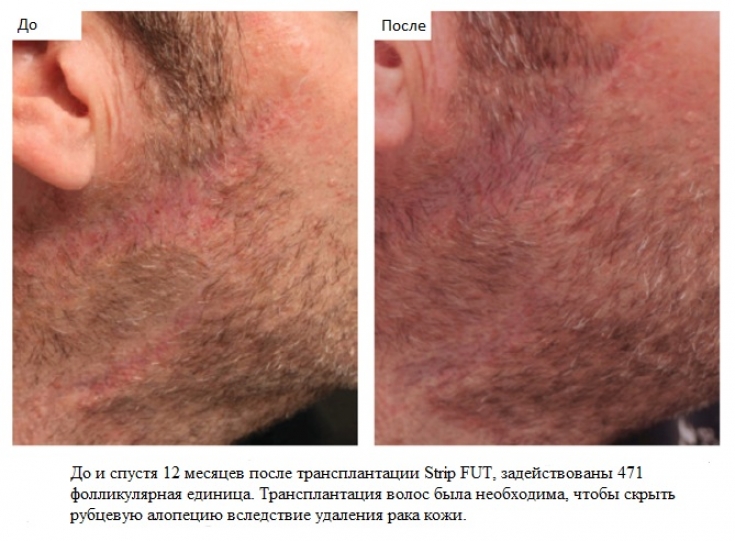Natural low hair density or sudden loss of facial hair is a common aesthetic problem in men, causing them psychological discomfort. Experts note the rapidly growing demand for hair transplantation in the beard and mustache area. One of the reasons – the popular "hipster movement", where thick facial hair – a fashionable element of the image of a man and an indicator of status. But not everyone can use the services of a specialist in facial hair transplantation, because this procedure has a number of contraindications. estet-portal.com will consider the features of hair transplantation in the beard and mustache area using the Strip FUT and FUE methods.
Contraindications for hair transplantation in the beard and mustache area
The following are the main reasons why beard and mustache hair transplantation is contraindicated.
Alopecia
Alopecia areata results in hair loss in small, circular patches. Despite the fact that both men and women are susceptible to this disease, alopecia on the face is typical only for men.
It is widely believed that alopecia areata – it is an autoimmune disorder that causes hair follicles to fall out because the body misinterprets them as foreign bodies. The causes of this disease are not yet fully understood, but it is known that it is associated with genetics and may be hereditary.
Many patients would like to solve the aesthetic problems associated with alopecia with hair transplantation, but experts strongly do not recommend doing this, because when moving hair follicles to the area of baldness, there is a high probability, that grafts will partially or completely be unable to grow in alopecia areata.
Doctors recommend that patients with this scalp condition undergo steroid injections that contain corticosteroids – an anti-inflammatory drug that is essentially a man-made version of a hormone produced by our adrenal glands. It suppresses the immune system to stimulate the growth of hair follicles for local and general action.
However, this, along with a corticosteroid for local and general action, is strongly discouraged in the case of a beard, as the face is particularly susceptible to the side effects of this treatment (bruising, discoloration, progression of skin conditions such as acne and rosacea).
Trichotillomania
Trichollomania – this is a mental disorder in which the patient feels the need & nbsp; pull out your own hair. The condition is characterized by an intense and repeated urge to pull out scalp hair, eyelashes, eyebrows, nose hair, pubic or facial hair such as a beard. Often this is a response to a stressful situation, and the person does it automatically, without even realizing it.
While surgery may temporarily correct aesthetic problems, it does not address the true cause of hair loss, so treatment in this case should not be recommended as the patient will likely be hairless again. Therefore, first of all, it is necessary to solve the problem of a psychological nature.
Dermatological diseases
Inflammation of the skin for any reason can lead to hair thinning and even hair loss. In general, patients with active skin disease, such as scarring alopecia and anterior fibrosing alopecia, cannot undergo hair transplantation because the disease must first be completely eliminated.
Indications for facial hair transplantation
Physical trauma, including surgery, can cause permanent or complete hair loss. The hair follicles are damaged and often replaced by scar tissue, which means no more hair will grow from that area. In such situations, beard hair transplantation is the only rational solution to the problem.
Also, patients who have received facial burns or scars after surgery, as a rule, can be transplanted hair in the area of the beard and mustache without any problems. In these cases, there is no reason that can provoke repeated hair loss after transplantation, so transplantation often gives good results.
But most often, men resort to facial hair transplantation, whose beard and mustache are simply not as thick as they would like ,

Basic methods of beard and mustache transplant operation – Follicular Unit Transplantation (Strip FUT) and Follicular Unit Extraction (FUE). Each method requires hair from the donor area, & nbsp; the donor, which is usually the back of the head. If a patient has a bald patch on his head, he needs to prioritize correctly: is hair or a thick beard more important for him?
Throughout the years, the practice of Strip FUT has been constantly improved, and today hair transplant surgery leaves a thin linear scar.
However, many patients, after viewing photos on the Internet, are very afraid of getting wide, rough scars. Although in fact, the photo they saw may be an isolated case, and deep scars were obtained from the hands of an inexperienced or unscrupulous doctor.
Male pattern baldness: how to work with such patients
Adapted from Aestheticsjournal.com







Add a comment